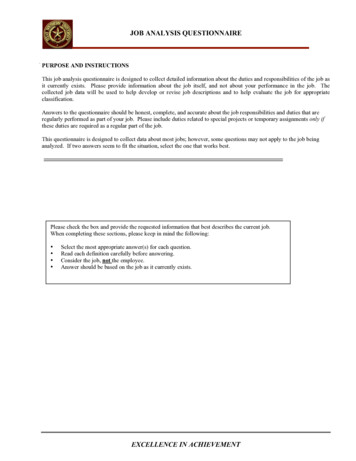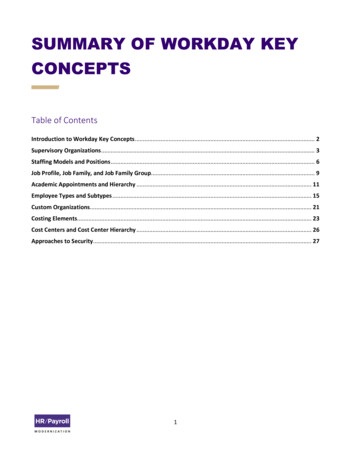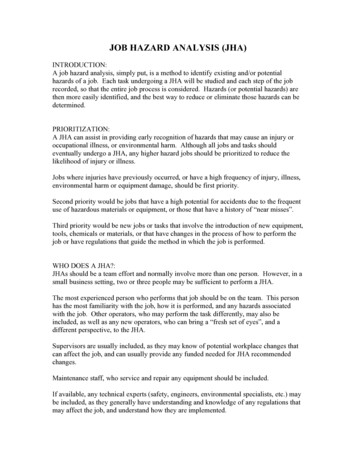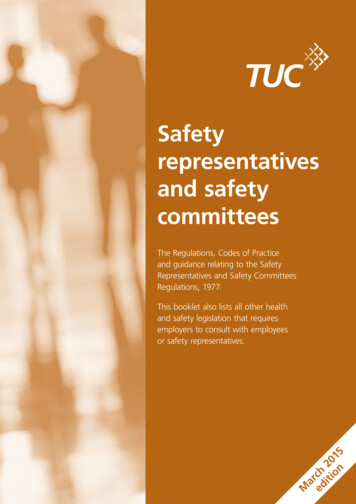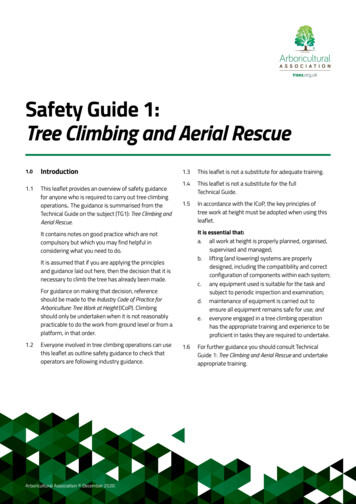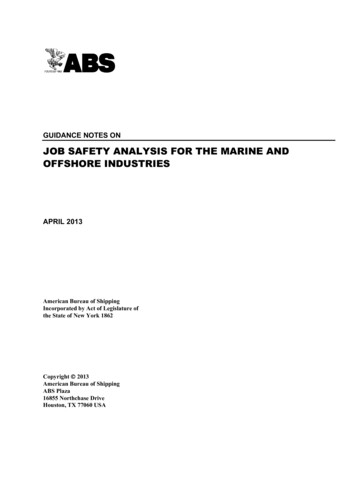
Transcription
Guidance Notes on Job Safety Analysis for the Marine and Offshore IndustriesGUIDANCE NOTES ONJOB SAFETY ANALYSIS FOR THE MARINE ANDOFFSHORE INDUSTRIESAPRIL 2013American Bureau of ShippingIncorporated by Act of Legislature ofthe State of New York 1862Copyright 2013American Bureau of ShippingABS Plaza16855 Northchase DriveHouston, TX 77060 USA
ForewordForewordJob safety analysis (JSA) is a risk assessment technique used to eliminate or reduce the occurrence ofundesirable incidents during work tasks. The intent of these Guidance Notes is to lay out a job safety analysis(JSA) process that aims to achieve a reduction in personnel injuries by establishing more effective workprocedures, addressing the specific challenges faced by the marine and offshore industries.These Guidance Notes should assist companies wishing to implement a JSA program from the start, oroptimize an existing program, by providing ideas and best practices that can be adopted by any marine oroffshore company to strengthen their safety management system.These Guidance Notes become effective on the first day of the month of publication.Users are advised to check periodically on the ABS website www.eagle.org to verify that this version ofthese Guidance Notes is the most current.We welcome your feedback. Comments or suggestions can be sent electronically by email to rsd@eagle.org.iiABS GUIDANCE NOTES ON JOB SAFETY ANALYSIS FOR THE MARINE AND OFFSHORE INDUSTRIES . 2013
Table of ContentsGUIDANCE NOTES ONJOB SAFETY ANALYSIS FOR THE MARINE ANDOFFSHORE INDUSTRIESCONTENTSSECTION 1Introduction . 11General . 13SECTION 21.1Standards and Regulations Requiring JSA . 11.3What is JSA? . 21.5Approaches to JSA . 2Terminology . 3Job Safety Analysis Process . 41JSA Process . 43Informal Job Safety Analysis. 4573.1When to Perform an Informal JSA . 43.3How to do an Informal JSA? . 5Formal JSA . 75.1When to do a Formal JSA? . 85.3How to do a Formal JSA?. 95.5Formal JSA Step 1: Define the Job . 115.7Formal JSA Step 2: List the Job Steps . 115.9Formal JSA Step 3: Identify the Hazards Associated with EachJob Step . 125.11Formal JSA Step 4. Identify Existing Control Measures for EachHazard . 155.13Formal JSA Step 5: Hazard Ranking . 165.15Formal JSA Step 5.1: Identify Additional Risk Controls . 175.17Formal JSA Step 5.2: Re-rank with Additional Risk Controls . 195.19Formal JSA Step 6: Validation of Controls . 195.21Sign Off . 20Simplified Formal JSA for Frequent and Moderately HazardousTasks. 22TABLE 1Informal JSA Characteristics. 5TABLE 2Formal JSA Characteristics . 7TABLE 3Tasks Typically Requiring a Formal JSA . 8TABLE 4Checklist of Hazard Types and Potential Causes(Non-Exhaustive) . 12ABS GUIDANCE NOTES ON JOB SAFETY ANALYSIS FOR THE MARINE AND OFFSHORE INDUSTRIES . 2013iii
SECTION 3FIGURE 1Informal JSA Checksheet . 6FIGURE 2Formal JSA Process . 10Getting the Most Out of a Job Safety Analysis Program . 231Environmental, Security and Emergency Considerationsin a JSA . 231.1Environmental Considerations . 231.3Security Considerations . 231.5Emergency Preparedness . 233A Word About Proximity in Time and in Location . 245Library of JSAs . 245.1Generic JSAs . 245.3Using a Library of Generic JSAs . 265.5Using a Library of Completed JSAs . 265.7Limitations of Library of JSAs . 267Synergism between JSA and Permit-to-Work .279Synergism between JSAs and Standard Operating Procedures . 279.111FIGURE 1SECTION 479ivGeneric JSA Example . 25Job Safety Analysis Program Implementation . 301Program Implementation.303Roles and Responsibilities . 305SECTION 5JSA as a Tool to Develop SOPs . 28Stop Work Authority and Ultimate Work Authority . 283.1Shore Management Involvement . 303.3Shipboard/Offshore Personnel Involvement and Responsibility . 313.5Contractors . 32Organizational Preparation . 335.1Culture . 335.3Management Support . 33JSA Program Manual . 337.1JSA Form . 337.3Risk Tolerance . 34Training . 35TABLE 1Sample Tolerability Criteria Based on Hazard Severity . 35FIGURE 1Sample Risk Matrix with Risk Tolerability Criteria . 35JSA Program Monitoring . 371JSA Program Monitoring .373Performance Indicators .375Documentation and Recordkeeping . 387Continual Improvement .389Select Resources . 40ABS GUIDANCE NOTES ON JOB SAFETY ANALYSIS FOR THE MARINE AND OFFSHORE INDUSTRIES . 2013
APPENDIX 1 Sample JSA Forms . 41Sample Basic JSA Form . 42Sample Comprehensive JSA Form . 43APPENDIX 2 Hazard and Controls Checklist . 441Hazard and Controls Checklist . 44TABLE 1Hazard List . 44TABLE 2Chemical Hazards with Possible Controls . 46TABLE 3Biological Hazards with Possible Controls . 49TABLE 4Energy Hazards with Possible Controls . 51TABLE 5Physical Hazards with Possible Controls . 56TABLE 6Work Environment Hazards with Possible Controls . 60TABLE 7External Hazards with Possible Controls . 63ABS GUIDANCE NOTES ON JOB SAFETY ANALYSIS FOR THE MARINE AND OFFSHORE INDUSTRIES . 2013v
This Page Intentionally Left Blank
Section 1: IntroductionSECTION11IntroductionGeneralRisk assessment, the proactive and systematic assessment of risks, is a standard element of most offshoreand maritime companies’ safety management systems. Risk assessment is a powerful and flexible tool toidentify and control potential undesirable events that can have safety, environmental, quality, or financialrepercussions.The focus of these Guidance Notes is risk assessment applied to work tasks, commonly referred to as JobSafety Analysis (JSA).The marine and offshore industries have implemented job safety analysis at varying levels of maturity andsophistication. These Guidance Notes provide considerations for any company desiring to strengthen their safetymanagement system through the use of a job safety analysis. The best practices and concepts contained withinthis document can be applied by any marine or offshore company wishing to initiate or improve their JSAprogram.1.1Standards and Regulations Requiring JSAA properly implemented JSA program constitutes an important risk management tool for compliance withseveral regulations, standards, and industry best practices, such as the ISM Code, the Occupational Healthand Safety Assessment Standard OHSAS 18001, the Maritime Labour Convention, the Tanker ManagementSelf-Assessment (TMSA), and the Safety and Environmental Management Systems (SEMS) regulationsfor the offshore industry in the United States. The International Safety Management (ISM) Code, 2010 edition, indicates that one of the safetymanagement objectives of the Company shall be to “assess all identified risks to its ships, personnel and theenvironment and establish appropriate safeguards”. A JSA can assist in the shipboard risk identificationprocess and the ensuing establishment of safeguards to appropriately control those shipboard risks. The Occupational Health and Safety and Assessment Series standard, OHSAS 18001:2007, in Section4.3 (Planning), requires companies to develop and implement a “procedure(s) for the ongoing hazardidentification, risk assessment, and determination of necessary controls” as the basis of the whole OH&Ssystem. The International Labour Organization (ILO) has developed the Maritime Labour Convention, 2006 thathas wide-spread applicability in the maritime industry. Part A of the Convention, Regulation 4.2 –Health and safety protection and incident prevention, mandates risk evaluations for occupational healthand safety risks. Risks due to noise, vibration, disease, exposure to asbestos, fire, and dangerous cargoesand materials, are to be identified and risk reduction controls provided. The Oil Companies International Marine Forum (OCIMF) developed the Tanker Management SelfAssessment (TMSA), a Best Practice Guide for Vessel Operators (2008), as a tool to encourage vesseloperators to assess and continuously improve their safety management systems by incorporating theprovided best practice guidance. Risk assessments are incorporated in several elements of TMSA, but themost encompassing requirements are in Element 9 “Safety Management”, which suggests Companiesshould have a program for systematic identification of hazards. The United States regulation for Safety and Environmental Management Systems (SEMS) for the offshoresector, as specified in 30 Code of Federal Regulations 250, Subchapter S, requires among other things,the development and implementation of a JSA program to analyze tasks performed as part of most offshoreactivities, such as drilling, production, processing, construction, well services (workover, completion,servicing), and pipelines.ABS GUIDANCE NOTES ON JOB SAFETY ANALYSIS FOR THE MARINE AND OFFSHORE INDUSTRIES . 20131
Section1.31GeneralWhat is JSA?A Job Safety Analysis is a task-oriented risk assessment used to review the hazards associated with a particularwork task, and to verify that adequate safeguards are in place to control those hazards. The main goal ofthe analysis is to prevent harm to the individual(s) carrying out the task. JSAs are known by a variety ofterms, including Job Hazard Analysis (JHA), Job Risk Assessment (JRA), Task Risk Assessment (TRA),Safe Job Analysis (SJA).JSA is the analytical process of: Identifying the basic job steps of the task, For every job step, reviewing associated potential safety and health hazards, and Planning for effective controls or safeguarding mechanism to control (i.e., eliminate or mitigate) theeffects the hazards may pose.JSAs are primarily used for controlling risks to the safety and health of the workers. However, a JSA canbe used as a tool to identify how the task can pose hazards to the environment or to the asset. Subsection 3/1discusses this topic further.In addition to identifying the inherent hazards of a task, a well-conducted JSA can uncover other subtleissues that pose risks to the individual, such as discrepancies between the way the procedures recommend atask to be carried out and the actual situation; problems with risk controls that supposedly act to reduce therisk but when brought to light during the JSA are found to be deficient, missing, inoperable, or bypassed;or the hazards associated with personnel change during the tasks.The identification of these problems and the implementation of corrective actions before the task is performedcan prevent undesirable incidents during the execution of the work task.1.5Approaches to JSAA company promoting a risk-conscious safety culture will ideally want to go through a JSA exercise beforeperforming any onboard/offshore activities. However, JSA exercises involve time and effort to developand document. A program that requires a documented JSA for every task onboard/offshore may be seen bysome as overly onerous, and the worker acceptance, rigor, and efficiency of the JSA program can diminish.On the other hand, if certain tasks are excluded from the JSA program, the workers may skip assessing thehazards associated with the task and the means by which they can be eliminated or reduced to an acceptablelevel.To illustrate this, consider a simple task routinely performed onboard ships. A crewmember has been assignedthe task of transferring large boxes of stores, approximately three-foot cubes, from the main deck to the shelvesin the Dry Stores Room. The Dry Stores room is below the main deck and stairs must be used.Hazards associated with descending the stairs include: Personal harm (e.g., bumps, bruises, back injury) from slipping and falling from the stairs Boxes slipping out of the person’s hands and striking another person below Dropping the box and breaking containers of chemicals inside that when mixed produce toxic, lethal,or otherwise harmful vaporsHazards associated with carrying the box in the passageways on the way to the Dry Stores Room include: Bumping into other personnel who cannot be seen over the top of the carried box Bumping into doorways and scraping fingers while going through Tripping over unseen objects in the passageway and dropping the box damaging contentsHazards associated with placing the boxes on the shelves in the Dry Stores Room include:2 Scraping hands on the shelves Back injury from trying to lift boxes to a higher levelABS GUIDANCE NOTES ON JOB SAFETY ANALYSIS FOR THE MARINE AND OFFSHORE INDUSTRIES . 2013
Section1GeneralA JSA would identify these hazards and identify, for example, the need for a second or third person to assistin the transport of the boxes, or to use a handy-billy and approved strap to lower the boxes to the next level,or to erect a small platform in the Dry Stores Room so that the boxes would not have to be as lifted as highas when placing on the shelves. The inclusion of additional personnel could, during the JSA discussion, identifyadditional hazards and control measures. However, requiring a comprehensive and documented JSA for atask such as the one described would be too onerous on the workers.Hazards associated with all tasks should be identified and controlled. However, some tasks require a moredetailed JSA than others. Instead of suggesting a JSA program where certain tasks are left without the benefitof the JSA, or a program where all tasks are required to undergo a formal and comprehensive JSA, a tieredapproach is recommended with two or more levels of JSA. Typically, two JSA levels could be defined:i)An informal JSA (mental or verbal)ii)A formal JSA (comprehensive and documented)The JSAs can be carried out to varying degrees of detail, depending on the situation at hand.A tiered JSA program necessitates criteria to decide what type of JSA is needed for each particular taskdepending on factors such as the type of task, its complexity, its regularity, etc. These Guidance Notes describethese two types of JSA along with guidance on when to use one versus the other, but ultimately, each companywill develop their program and criteria according to their needs and goals.3TerminologySeveral terms used throughout these Guidance Notes are defined below.Consequence is the measure of the impact of an event occurrence in terms of people affected, propertydamaged, outage time, dollars lost, or any other chosen parameter. For purposes of a JSA, the focus is onimpacts to safety and health, but impacts on environment and property can also be considered and mitigated.Controls are the measures taken to prevent hazards from causing undesirable events. Controls can be physical(e.g., safety shutdowns, redundant controls, added conservatism in design), procedural (e.g., operatingprocedures, routine inspection requirements), and can also address human factors (employee selection, training,supervision).Event is an occurrence that has an associated outcome. There are typically a number of potential outcomesfrom any one initial event that may range in severity from trivial to catastrophic, depending on other conditionsand subsequent events. The terms Event and Incident are used interchangeably.Hazards are conditions that exist that may potentially lead to an undesirable event.Incident. Same as Event. Both concepts may include near misses (unsafe conditions) and injuries.Job Safety Analysis (JSA) is an analytical process that focuses on a means to identify and control hazardsinherent in job tasks before they can result in an accident. JSA also refers to the formal document that isdeveloped as a result of the analysis process.Likelihood indicates the potential that a hazard could be realized.Risk is defined as the product of the frequency with which an event is anticipated to occur and the consequenceof the event’s outcome.Risk Assessment is the process of understanding (1) what undesirable things can happen, (2) how likelythey are to happen, (3) how severe the effects can be and (4) evaluating what is the risk of each undesirableevent.ABS GUIDANCE NOTES ON JOB SAFETY ANALYSIS FOR THE MARINE AND OFFSHORE INDUSTRIES . 20133
Section 2: Job Safety Analysis ProcessSECTION12Job Safety Analysis ProcessJSA ProcessA JSA focuses on identifying the tasks necessary to perform a specific job; the potential safety and health,and in some cases, environmental, hazards associated with each task; and the possible risk control measuresneeded to eliminate or reduce these hazards. The JSA process can be divided into a number of steps, thecomplexity of which can vary depending on the job being analyzed. As mentioned before, it can be usedinformally through a verbal discussion before performing a simple, routine job, or formally following aprescribed set of steps and a well-defined JSA form for more complex, non-routine, or new jobs. The JSAprocess presented in these Guidance Notes is a flexible approach that can accommodate any level of detail.A so called informal JSA process is described, as well as a formal JSA process for more complex jobs. Evenwithin the formal JSA, the process can be applied at different levels of detail, depending on the complexityof the job. It can take minutes to several hours to complete. These Guidance Notes describe a range ofoptions in terms of level of detail and complexity of each JSA process step. Each company can modify andadapt this JSA process to the appropriate level of detail for the different type of jobs applicable to them.Regardless of the type of JSA to be performed, there are three basic parts that need to be completed: Understand the task to be performed Identify potential hazards for the task Identify risk control measures for each hazardThe following sections provide guidance on how to complete these basic parts, with varying levels of detailappropriate for each type of JSA approach.3Informal Job Safety AnalysisInformal JSAs are mental or verbal individual risk assessments carried out by the worker(s) before startingany job. They are the most basic, quickest and simplest of task risk assessment, which help promote a riskmanagement culture through continual self-evaluation. They aid in the identification and control of immediatehazards as personnel conduct their day-to-day work, and assist personnel in maintaining situational awarenessof their environment at all times.The informal JSA described here is similar in nature to other planning tools that share the same intent: helpworkers perform even the most mundane of tasks without getting hurt. These personal planning tools includetechniques such as Stop and Think, Take 5, Stepback 5 5, Good to Go, Every Minute Risk Assessment,or Toolbox Talk.3.1When to Perform an Informal JSAThe informal JSAs are generally used for routine and simple tasks involving only one or two individualsand little equipment. The following tasks are examples for which an informal JSA is appropriate: Routine materials and stores handling (e.g., moving dry stores from the storeroom to the galley, stockingstoreroom shelves with received stores, etc.) Routine maintenance tasks (e.g., painting and chipping in open air, changing air conditioning filters, etc.) Routine housekeeping activities (e.g., mopping decks, cleaning up tank cleaning equipment, etc.). Routine and repetitive operations (e.g., tripping pipe in or out of the hole, connecting cargo hoses, applyingsecuring devices to cargo or stores at deck level, etc.).Personnel should be made aware that any time there is uncertainty regarding the risks, or a suspicion ofhigh risks associated with the performance of a task, a formal JSA should be conducted.4ABS GUIDANCE NOTES ON JOB SAFETY ANALYSIS FOR THE MARINE AND OFFSHORE INDUSTRIES . 2013
Section3.32Job Safety Analysis ProcessHow to do an Informal JSA?A typical informal JSA involves taking a moment before starting the job to consider the following factors,trying to identify their inherent hazards, or what can go wrong with each one of them:i)Taskii)Work e identification of hazards leads to methods to manage the risks associated with the hazard. The JSAshould be repeated throughout the duration of the task to account for changing conditions or circumstancesand prompt the worker to step back and think through emerging issues.Personnel doing the work are responsible for carrying out the informal JSA and supervisors are responsiblefor encouraging and communicating the process.Section 2, Table 1 provides a summary of the characteristics of an informal JSA.TABLE 1Informal JSA CharacteristicsCharacteristicsInformal JSAJSA LeaderIndividual working on the task.Number of people on JSA teamTypically 1-3. All conducting the task should participate in the JSASupervisor during JSA developmentNot necessaryDocumentation and recordkeepingNoneApprovalsNoneRisk estimationMental. Worker feels confident that risks are acceptable.Level of detail on breakdown of job stepsMental or verbal outline of the task.Location for Conducting the JSAShipboard/facility and close to the task locationTiming for Conducting the JSAImmediately before the taskOnly identified hazards can be managed and controlled. A checksheet for informal JSAs is shown inSection 2, Figure 1, with sample questions to help “prime” the hazard identification process. As a supportingtool, this informal JSA checksheet, or a similar one customized for a company, can be laminated and providedto all workers to carry around or have handy at all times.ABS GUIDANCE NOTES ON JOB SAFETY ANALYSIS FOR THE MARINE AND OFFSHORE INDUSTRIES . 20135
Section2Job Safety Analysis ProcessFIGURE 1Informal JSA Checksheet6ABS GUIDANCE NOTES ON JOB SAFETY ANALYSIS FOR THE MARINE AND OFFSHORE INDUSTRIES . 2013
Section52Job Safety Analysis ProcessFormal JSALike the informal JSA, a formal JSA focuses on identifying hazards associated with performing a specificjob, the potential safety, health, and in some cases environmental hazards associated with each step; andthe recommended risk control measures needed to eliminate or reduce these hazards.The main difference between an informal and a formal JSA is that the latter process has an expanded levelof detail and is documented. A formal JSA documents the job steps, the identified hazards, and the meansby which the risk of these hazards is eliminated or mitigated. The documentation becomes a means ofcommunicating information about the job. All personnel involved in the job and the assessment have accessto the results and can provide additional input as appropriate. Formal JSAs should be filed for future referencewhenever the same, or similar, task arises. These JSAs should be reviewed and adjustments made as necessaryto fit the existing conditions at the later time (i.e., time of day, type of weather, experience level of taskparticipants, time restraints, etc.).Section 2, Table 2 provides a summary of the characteristics of a formal JSA.TABLE 2Formal JSA CharacteristicsCharacteristicsFormal JSASee SectionJSA LeaderIndividual experienced in the task to be carried out and in the JSA process.It could be an individual working on the task, a supervisor, or an HSEperson from shore with indirect knowledge of the task.4/3, “Roles andResponsibilities”Number of peopleon JSA teamAll individuals involved in the job should participate in the JSA development.In addition, the presence of external support such as shoreside, HSE, orother departments may be needed for certain tasks.4/3, “Roles andResponsibilities”Use of not taskspecific, genericJSA formsGeneric JSA can be used as reference, but a new JSA should be conductedprior to commencing the task which addresses all hazards associated withthe task, including time of day, personnel experience, change of personnelduring the task, environmental considerations, etc.3/5, “Library of JSAs”Supervisor presentduring JSAdevelopmentYes. In addition to supervisor/officer in charge, for large-scale, complextasks, consideration should be given to oversight by the Master, OffshoreInstallation Manager or by shore-office HSE expert.4/3, “Roles andResponsibilities”Detailed breakdownof job stepsBreakdown performed in conjunction with detailed tasks or processinstructions and referenced to Company procedures2/5.7, “Formal JSA Step2: List the Job Steps”Risk EstimationExplicit risk estimation required, according to company procedures. Usually,it involves a qualitative assessment of consequence and likelihood with thehelp of a risk matrix2/5.13, “Formal JSAStep 5: Hazard Ranking”Timing and locationof JSAIn close proximity to the task location, as well as shortly before commencingthe task.If a JSA was performed well in advance of the task in order to allow time toinstall any recommended engineering controls, such JSA must be reviewedagain prior to commencing the task with all the personnel involved in thetask.3/3. “A Word aboutProximity in Time andin Location”ApprovalsYes, approval of the JSA analysis needed before starting the task. Approvalprocess according to company procedures, usually by the relevant memberof offshore facility management, Master, Offshore Installation Manager,HSE or shore-office.4/3.3.2, “Approvals”Documentation andrecordkeepingYes, according to company procedures. Records stay on vessel and usuallyshoreside also.5/5, “Documentationand Recordkeeping”ABS GUIDANCE NOTES ON JOB SAFETY ANALYSIS FOR THE MARINE AND OFFSHORE INDUSTRIES . 20137
Section5.12Job Safety Analysis ProcessWhen to do a Formal JSA?A formal JSA shall be carried out for new major tasks or groups of tasks, or when the informal JSA hasbeen found not to suffice/ or when required by Company procedure. A task involving one or more of thefactors below should normally trigger a formal JSA:i)Non-routine tasksii)Tasks with known potential for
the analysis is to prevent harm to the individual(s) carrying out the task. JSAs are knownby a variety of terms, including Job Hazard Analysis (JHA), Job Risk Assessment (JRA), Task Risk Assessment (TRA), Safe Job Analysis (SJA). JSA is the analytical p



